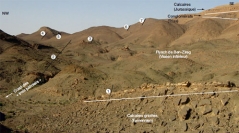

 Geodiversitas
37 (1) - Pages 5-29
Geodiversitas
37 (1) - Pages 5-29The anticlinal structure of Ben-Zireg is located in the marginal zone of Sahara, near the Algerian-Moroccan border. It represents a key region situated between the Mesetian domain in the North and the Anti-Atlas-Ougarta field in the South. In this area, the sedimentological and geodynamic aspects of the Carboniferous series have been little studied in the previous studies. The present work is mainly field-based and focuses on stratigraphic and facies analysis in order to characterize the depositional environments and palaeogeography of the “flysch de Ben-Zireg” formation assigned to the lower Visean.
Based on lithologic and sedimentologic characteristics, we can subdivide the “flysch de Ben-Zireg” formation into four informal units. From the base to the top they are: 1) the “pre-flyschoïde” unit is well developed at the Oued “des trois palmiers” section. It is composed of whitish pelites commonly contains small bivalves and fishes, followed by an alternation of green pelites with sandstones and bioclastic limestones containing transported mollusc shells. The sandstone beds show massive bedding, parallel lamination and small-hummocky cross-stratification; 2) the “wildflysch” unit shows differences in characters and thickness from one locality to another. It is dominated by slumped green pelites including metric to plurimetric olistoliths, debris-flows, and turbidite sandstone and conglomerate intercalations. The age of the exotic elements ranges from Ordovician to Lower Carboniferous (Tournaisian); 3) the “flyschoïde” unit can be traced from east to west of the northern side of the anticlinal structure of Ben-Zireg. It consists mainly of regular alternation between green pelites and light brown turbidite sandstone beds, showing high sand/pelite ratio. Individual sandstone beds are tabular, laterally continuous and often a sharp planar or smooth irregular erosive base. Synsedimentary deformations (slumps), thin pebbly levels, flute-, groove and load-casts occur locally. The main characteristic of the sandstone beds is the occurrence of the Bouma (1962) divisions, with normal graded bedding, parallel lamination, convolute bedding, water-escape structures and current ripples. Trace fossils are rare. Hectometric olistoliths of eifelian reef and cambrian-ordovician sandstones are also intercalated in the middle part of the “flyschoïde” unit; and 4) the “post-flyschoïde” unit represent the uppermost part of the studied succession. It is composed of an alternation of green pelites with sandstone, conglomerate, bioclastic limestone and calcareous sandstone beds.
Facies analysis is the main tool for interpreting the environmental setting of the lower Visean deposits outcropping in the Ben-Zireg area. Based on field observations such as lithology, texture, grain size, sedimentary structures, fossil content and boundary features of beds, nine facies types have been recognized, described and interpreted in terms of depositional environment. The vertical and lateral distribution of the facies types F1-9 revealed four distinct facies associations, AFA to AFD, that reflect different environmental settings: The AFA is restricted to the lowermost (“pre-flyschoïde”) and uppermost (“post-flyschoïde”) parts of the lower Visean succession.” It is interpreted as a marine offshore to shoreface, storm-wave influenced deposits; The AFB represents the lower portion of the “wildflysch” unit. It consists of a thick slumped pelites including several debris flows levels and olistoliths from previous formations, conglomeratic channels and turbidite sandstone beds. This disorganized facies association is the result of tectonic instability and mass-transport processes (slumps and debris flows) at the non channelized base of slope apron with sheet turbidite; The AFC represents the middle part of the “wildflysch” unit. It includes channelized conglomerate beds and turbidite sandstones in alternation with green pelites containing olistoliths of different sizes. These sedimentary facies form thinning-upward and fining-upward cycles of some meter-thick, interpreted as mid-fan channel-fill and channel-fringe deposits. The AFD coincides with the deposition of the “flyschoïde” unit. It is characterized by monotonous alternations of sharp-based turbidite sandstones and interbedded pelites. These alternations are organized in metric thinning-upward sequences of a great lateral continuity and high sand/pelite ratio. They can be referred to lobe-fan fringe environments. The marker chaotic level (eifelian and cambrian-ordovician olistoliths) is interpreted as the product of destabilization of the inner foredeep slope sediments, probably in relation to the tectonic thrust, or the decreasing sea-level.
The lithostratigraphic correlations with adjacent areas and the recognized facies associations allow us to follow the palaeogeographic evolution of Ben-Zireg area during the lower Visean, which took place in three principal stages: 1) installation of a carbonate-siliciclastic platform influenced by storms actions (“pre-flysch” unit), following a forced regression period attested by the paleosol level and the lack of Strunian and Tournaisian rocks recognized in large outcrops in the adjacent areas; 2) individualization of tectonic trough delimited by normal faults (graben structure), filled by a chaotic sedimentation (wildflysch unit). This phase is controlled by an active tectonic attested on the field by the lateral changes in thickness of the sedimentary bodies, plastic deformations (slumps) and synsedimentary faults, olistoliths of large size and debris flows deposits; and 3) installation of a sand-rich and low-efficiency turbidite system, depending on active subsidence. The high sand/pelite ratio indicates the proximity of origin of detrital material. The “flyschoïde” deposits are capped by mixed platform rocks (“post-flyschoïde” unit) and by reefal and subreefal limestones, related to the tectonic quiescence and the eustatic sea level rise.
Ben-Zireg, Algeria, Lower Visean, flysch, lithostratigraphy, sedimentology, tectonics, palaeogeography